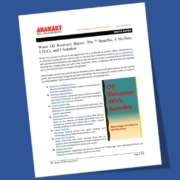Waste Oil Recovery Basics: The 7 Benefits, 4 No-Nos, 3 TLCs, and 1 Solution
 Waste oil recovery is critical to any application for a multitude of reasons. Many companies try, or should be trying (tsk tsk if you’re not), to recover their used oil in order to stay in compliance with government standards and regulations. No one wants to pay a massive fine or, even worse, don the orange jumpsuit with silver bracelets when complying with the law and keeping our environment clean is a simple enough task.
Waste oil recovery is critical to any application for a multitude of reasons. Many companies try, or should be trying (tsk tsk if you’re not), to recover their used oil in order to stay in compliance with government standards and regulations. No one wants to pay a massive fine or, even worse, don the orange jumpsuit with silver bracelets when complying with the law and keeping our environment clean is a simple enough task.
Additionally, recovering used oil has its monetary perks. Reclaimed hydrocarbons can be sold for profit and removing it properly can help extend the life of equipment, wastewater, or coolant. All while Mother Earth smiles and the people rejoice. Everybody wins.
Find out the 7 Benefits…
- Reduction of Disposal Costs
- Recycling Opportunities
- Extend Coolant Life
- Esthetic Benefits
- Extend Tool Life
- Avoid EPA Violations
- Hygienic Benefits
Over the years we have seen some troubling scenes. The things people do to oil skimmers…it is horrific. Years upon years of oil and incalculable layers of gunk encrusted all over the machine. Discharge valves clogged to the point where the skimmed content barely drips out. THE ORIGINAL BELT. For shame. All of you.
Look at the 4 No-Nos…

So how do you know when it is time to show your oil skimmer some TLC? Here are some things to look out for:
- Are the wiper blades on your oil skimmer making smooth contact with the belt?
- Is the belt riding away from the sides of the pulley?
- Has the belt seen better days?
Oil skimmers are very simple pieces of equipment that can help you tackle a very serious wastewater issue. They are a low-cost and environmentally sound solution to waste oil recovery. They are by no means high-maintenance or difficult to use, but do require some routine work every now and then and a little tinkering here or there. Bottom line is, replacing a wiper blade system or belt on an oil skimmer beats having to pay a fine to your respective government environmental agency.




